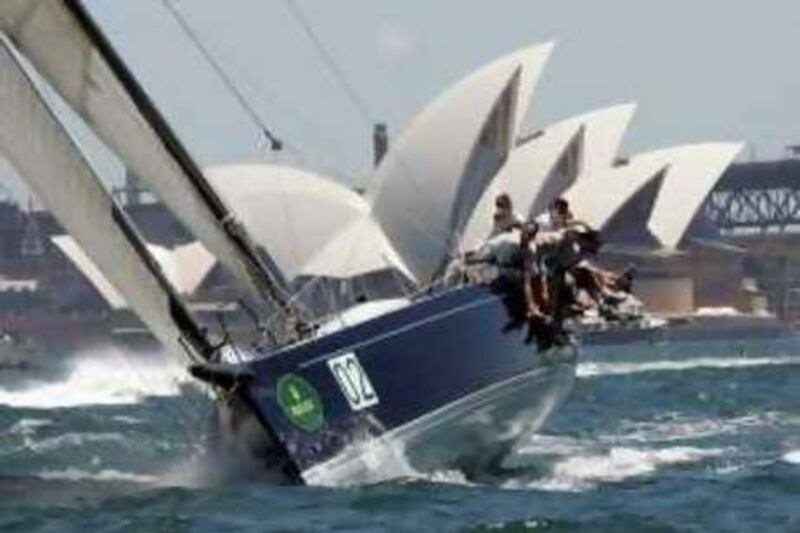SYDNEY // Australian weather forecasters are predicting lightning fast times for participants in the annual Sydney to Hobart yacht race that starts today. The 628-nautical mile dash south is one of the world's toughest ocean competitions and takes boats down Australia's wild south-east coast, across the unpredictable Bass Strait before they enjoy the calmer waters of Tasmania's Derwent River and then cross the finishing line in the state capital, Hobart.
The iconic race began in 1945 and has become a treasured part of Australia's sporting landscape. It starts in Sydney's picturesque harbour where as many as 500,000 spectators are expected to watch from the shore as crews jostle for position before heading out into open sea. This year about 100 vessels, including boats from the United States, Germany and New Zealand, will take part in what can be a hazardous voyage.
In 1998, six sailors died when monstrous storms packed with winds of up to 80 knots and giant waves battered the fleet. In such brutal conditions five yachts sank, while 66 boats retired and more than 50 sailors were plucked to safety by helicopters in what was one of Australia's biggest peacetime rescue missions. "We'll certainly be thinking of them [the victims] and hopefully we won't have a race like they did," said Sally Smith, one of only two female skippers in the race, who is competing in the blue water classic for the first time.
"I'm very, very excited. It's a huge challenge," Mrs Smith said as she sipped coffee and munched biscuits with her crew on board her father's 18m craft Helsal IV. "It's just such a great race to be involved in. It's known all around the world, and it's a very difficult race because of the challenges throughout Bass Strait, which can be very treacherous. "We're expecting a really good run for the first couple of days. We should scream down the coast sitting on about 12 knots and hopefully we'll get into Hobart in three days."
The race record stands at one day, 18 hours and 40 minutes, but that is expected to come under pressure when the fleet is helped down the coast by gusty northerly winds. The boats receive detailed weather reports as they plot their course from Australia's largest city to Hobart. An inaccurate forecast, which downplayed the threat of storms, contributed to the 1998 tragedy but the system is far more accurate now.
Bruce Gould lost three crew mates when his vessel, the Winston Churchill, sank a decade ago. "We had a good run down the New South Wales coast, and then a big front was coming through, so we got ourselves set up for that, but it was far bigger than any of us expected. In fact, three fronts merged together and we were in really bad conditions. "One huge, rogue wave hit us, drove the boat backwards and broke on top of us and we suffered extreme damage and unfortunately the boat started to sink." Mr Gould was below deck at the time and was catapulted across the cabin before a mayday distress signal was made.
The Winston Churchill's crew escaped into two life rafts. Within a few minutes, the boat had disappeared beneath a ferocious sea. Mr Gould and his companions drifted for 25 hours before help finally arrived and they were winched to the safety of a helicopter. Three fellow sailors on another raft were not so fortunate and died when they were swept away. This year, wreaths will be laid to remember those who died competing in the most demanding of races.
"Every time I go to sea I think about it and particularly at this time of year," Mr Gould said. "It brings back some pretty terrible memories and obviously it's a time to reflect how lucky you were to survive and you certainly think of the tragedy of losing three of your shipmates." Despite the appalling events of 1998, for the competitors the Sydney to Hobart is a chance to conquer nature's extremes.
"It's a race where you encounter all different types of weather," said John Walker, who at 86 is the oldest sailor in this year's event and expects to complete the trip south in his 10m craft Impeccable in four days. "You get everything from a northerly to a southerly, calm to a storm and you deal with it as it comes. You have some easy times and you have some hard times. "Once you start the race you get into a routine. The crew is split up into two watches of three, leaving me to attend to the radio, to the weather reports, to the navigating and to steer the boat. The four days go pretty quickly," Mr Walker said.
Ultra-modern super maxi Wild Oats XI is heavily tipped to win this race for the fourth year in a row and could eclipse the record it set in 2005. @Email:pmercer@thenational.ae





